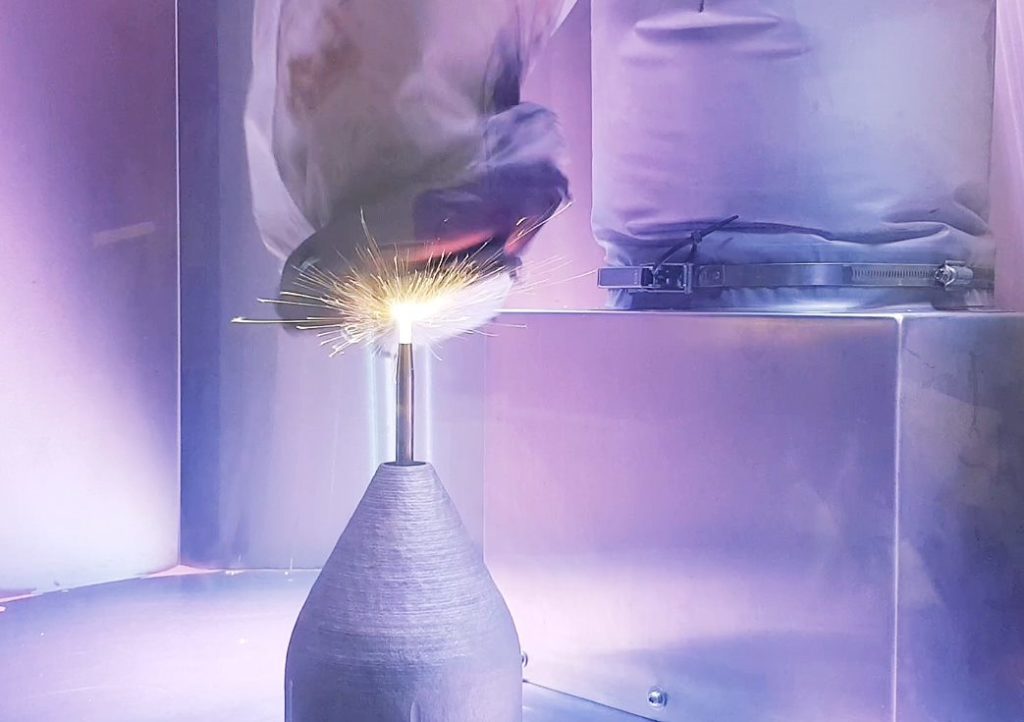Australian 3D printing firm SPEE3D has introduced a new nozzle which allows the firm’s technology to 3D print in stainless steel, titanium and nickel-based carbides. Nickel-based carbides are high-strength metals, such as MAR-M247, which are of particular interest to NASA and the like for hypersonics, turbo machinery, and rocket applications. This expands SPEE3D´s materials portfolio from copper, aluminum bronze, and aluminum, allowing the firm take on many new applications, parts, and clients.
The new nozzle, called Phaser relies on compressed air or nitrogen to 3D print metal at “four times faster than the speed of sound at much higher energy.” The company explains that the technology makes it possible to reach “high particle velocity to enable more deformation of particles during the deposition process,” which results in the ability to use harder materials.
“The SPEE3D PHASER nozzle is revolutionary because anyone can print what’s considered ‘hardier’ materials, and without having to rely on helium to cold spray these materials like other nozzles. With supply chain issues continuing to delay parts for industries such as space, defense, auto racing and maritime, the Phaser nozzle can create these parts in just minutes to withstand severe conditions, high stress, immense shock loads and abrasive environments,” Steve Camilleri, Co-founder and CTO, said.

SPEE3D’s cold spray process and Australian location have always made them a bit of an exotic offering in the 3D printing world. Kind of the 3D printing OEM equivalent of Jensen, Ascari, or Noble. Those niche sports car manufacturers found it tough going, however, having difficulties finding scale, financing, and distribution. Sometimes being a little bit different and far away can almost doom you to be stuck in a little corner somewhere, fighting for every morsel of attention.
However, SPEE3D now has printers installed as far as El Salvador. The U.S. Army’s Rock Island Arsenal has two. Its machines are being used for maintenance, repair, and overhaul (MRO); military applications; and rocket engines. In fact, SPEE3D has some very distinct advantages that give it a possibly very bright future:
Speed
The deposition speed of the technology means that businesses can deposit 30 tonnes of material per year. For very low cost, very high yield parts, SPEE3D could have a unique or near-unique capability.
Toughness
Their equipment is comparatively rough and tumble and can be used in austere environments. The Australian Navy has trialed the product as has the Australian Army, in the middle of nowhere.
Location, Location, Location
They are in Australia. Its remoteness and competitive lack of 3D printing activity can be a handicap. However, this is an advantage because the county will want to promote its indigenous 3D printing capabilities, especially in defense. In so doing, they could lavish attention and money on SPEE3D and Titomic.
This advantage in particular is compounded because the country is going to be working on hypersonics with the U.S. and the U.K.. For hypersonics, materials will be difficult to work with and very expensive. Every gram saved will be very valuable, therefore. Everything will have to be designed so that the craft won’t tear itself apart, which leaves a strong role for 3D printing to design optimized structures and surfaces.
This could be a real boon for the company, since the U.K. will want to promote Renishaw and the U.S. 3D Systems, as well as many more firms. Australia has few additive businesses and SPEE3D´s capabilities would match larger structural parts, which would mean that it would compete with MELD, Sciaky, and several others, but not everyone. This gives the company a big chance at hypersonic money. Even if they don’t get into this game the company really has a very tight niche that it could target well.
Deployability
The technology is ideally suited for MRO in the middle of nowhere for comparatively large, simpler, low-cost parts. With that in mind, the link between them and MRO on oil platforms, at sea, or for the military becomes quickly obvious.
Many technologies work okay for many applications. These are often difficult to commercialize. SPEE3D seems an ideal fit for MRO in austere environments for straightforward objects made on demand. The limited market fit is actually a boon, since it is clear that the company should focus on parts for navies, armies, shipping, shipbuilding, ship and vehicle MRO, larger specialized vehicle and the like. The task at hand, therefore, is comparatively well understood and everything is so much easier and better if your ideal future is known to you.
Subscribe to Our Email Newsletter
Stay up-to-date on all the latest news from the 3D printing industry and receive information and offers from third party vendors.
You May Also Like
3D Printing News Briefs, April 27, 2024: Research, Digital Dentistry, Cycling, & More
We’re starting today’s 3D Printing News Briefs with some research into 3D printed luminescent quantum-dot polymer architectures and free-form laser beam shaping, and then on to an open source 4-axis...
HP & INDO-MIM Collaborate to Boost Metal 3D Printing in India
HP Inc. and INDO-MIM, a US- and India-based supplier of metal injection molding (MIM) powders and contract manufacturer, have announced that the two companies will collaborate to accelerate additive manufacturing...
3D Printing News Briefs, February 17, 2024: Shot Blasting, Service Bureaus, & More
In today’s 3D Printing News Briefs, we’re starting out with post-processing, as SKZ Würzburg is using a shot blast system from AM Solutions for its research. Moving on to business,...
3D Printing News Unpeeled: Not That Kind of Organ 3D Printing
GKN Aerospace will create a 150 jobs in Trollhattan Sweden with an investment of $60 million part of which comes from the Swedish Energy Agency’s Industriklivet initiative. The investment will...






























